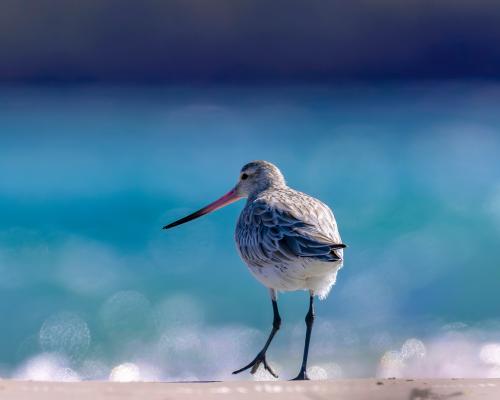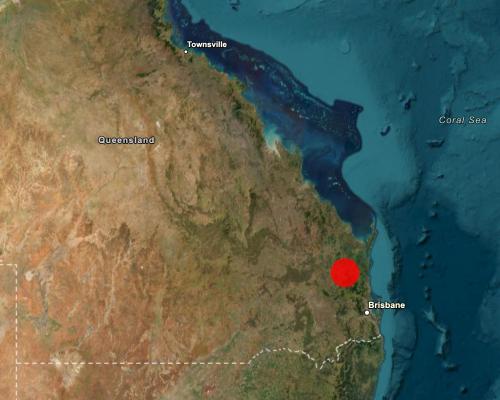
More people have heard of Robbins Island than have seen it. Separated from Tasmania’s north-western tip by a stretch of water that can be navigated only at low tide, the island is nearly 10,000 hectares of heathland and woodlands, paddocks, unusual geology and wetlands, all ringed by pristine beaches.
The island has been owned by the Hammond family, who use it to run Wagyu cattle, since the 1960s. Further back it was home to the Pirilyunya people for tens of thousands of years.
Its future is contested. After repeated delays, it is expected to be decided by the federal environment minister, Murray Watt, this month.
For eight years, the renewable energy company Acen Australia has been planning to make the island home to what would be one of Australia’s largest windfarms. If approved, it says, it would spend more than $3bn as it builds up to 100 turbines (maximum height: 212 metres), a 500-metre wharf and a 1.2km bridge. A 120km transmission line through forest and farms across the state’s north-west will require a separate approval.
-
Sign up to get climate and environment editor Adam Morton’s Clear Air column as a free newsletter
Acen says it is one of the best wind energy sites in the country, with the capacity to generate at least a third more electricity than an average windfarm the same size. The turbines would be powered by what the Hammonds have described as the world’s cleanest air – the roaring forties, which blow unimpeded across the southern Indian Ocean to the Tasmanian west coast.
The proposal is backed by the state’s Liberal and Labor parties, and the business community. The head of the Tasmanian Chamber of Commerce and Industry, Wayne Davy, says it is “absolutely essential” to meet growing power demand, and has urged the federal government to approve it to “create jobs, investment and huge benefits for the Tasmanian economy”.
But it is opposed by environmental organisations and some scientists. They agree that the country needs more renewable energy in a hurry to replace ageing coal plants and cut greenhouse gas emissions, but argue the site is wrong.
‘To us, it is a no-go site’
The intertidal mudflats at Robbins Island and in the surrounding area are considered internationally important feeding habitat for migratory and residential shorebirds, including more than 15 species that travel from the northern hemisphere each year via the east Asian-Australasian flyway. Some of these species, including the curlew sandpiper, far-eastern curlew and red knot, are listed as threatened. Some shorebird populations are estimated to have fallen by more than 70% since late last century.
Environmentalists say the 720-megawatt farm could also threaten endangered Tasmanian wedge-tailed eagles, the vulnerable blue-winged parrot and the critically endangered orange-bellied parrot, which flies from the Australian mainland to Melaleuca, in the Tasmanian wilderness world heritage area, each summer to breed. The orange-bellied parrot has been the focus of an intensive government-funded recovery effort. Its wild population remains tiny. It fell to just 17 before increasing to nearly 100 last winter.
-
A flock of red knots, a threatened species
The question facing Watt is whether the windfarm can be designed in a way that shields these and other threatened species – notably, a disease-free population of Tasmanian devils – that he is required to protect under national environment law. He will be making the decision before a long-promised overhaul of the law, which has few defenders and is widely agreed to be failing.
The timing places Robbins Island at the centre of an argument about how to balance the need to preserve Australia’s wild places and wildlife, including a ballooning list of species at risk of extinction, while allowing a rapid rollout of renewable energy.
-
Curlew sandpipers and a hooded plover
Conservationists argue there are some places development should just not be allowed, and they include Robbins Island. Sean Dooley, a senior adviser at BirdLife Australia, says: “To us, it is a no-go site.”
“It is such a vital staging post and feeding site for shorebirds – certainly, the most important site in Tasmania,” Dooley says. “Birdlife Australia sees climate change as one of the two major things that are going to impact and reduce bird populations, and we need to get on top of it as soon as we can. But it’s essential, in trying to deal with that, we don’t exacerbate the other major threat, which is destroying habitat.”
Eric Woehler, an ecologist and former convener of BirdLife Tasmania, describes the proposed site as “completely inappropriate”. He says the company’s bird surveys have been “fundamentally inadequate”, but that the best available orange-bellied parrot data – from radio-tracking of its 2024 northern migration – suggested half the birds that showed up on monitoring had visited Robbins Island.
-
A white-bellied sea eagle
“If this is approved there is a very real and very frightening prospect of the loss of orange-bellied parrots in the wild from collision risk,” he says. “There is a very great risk to the wedge-tailed eagle population in the area. There is a very great risk to the migratory shorebirds that fly from Siberia to Tasmania to feed in the Robbins passage area every year for six months.”
‘We believe the risks can be mitigated’
The windfarm has had a difficult path to final decision stage. It has had to clear local and state hurdles, and a federal decision has been delayed seven times. In 2021 Guardian Australia revealed that federal officials had raised concern about the impact on about 150 devils that have been geographically protected from a contagious facial tumour disease that has devastated other populations, had advised the company the impact on the species could be difficult to offset.
In 2022 the Tasmanian Environment Protection Authority notionally approved the development, but said it must shut down for five months each year during orange-bellied parrots’ migration season. This was widely seen as a decision that would block the development, given the shutdown would make it financially unviable. But the EPA ruling was overturned on appeal. A counter-appeal against the project by the community group Circular Head Coastal Awareness Network lost in the supreme court.
Acen says it is confident the risk to birds and devils can be managed and has changed its plans to address concerns that have been raised, including reducing the number of turbines by 20%, carving out part of the northern end of the island from development and promising a 500-metre buffer around sites that shorebirds gather.
It says there is no evidence from surveys that shorebirds fly across the island – a point that is strongly disputed by campaigners – and, despite radio-tracking surveys last and this year, that little is known about orange-bellied parrots’ flight path or the height at which they travel.
Michael Connarty, Acen’s head of operations and trading, acknowledges that the length of the development process has been frustrating and says the project has probably been scrutinised as much as any in Tasmania’s history. He argues that the development will benefit the local community, including creating up to to 400 jobs in construction and 60 during operation, help power clean industry in the state and send any excess electricity across Bass Strait. Acen hopes Watt approves it with conditions that outline the risks it needs to navigate.
“We believe the risks can be mitigated,” Connarty says. “It’s not like this is like a rubber stamp process over eight years. There has been high-level scrutiny of the project in terms of the risk and mitigations and we’re hopeful that it’ll be a positive outcome with conditions, and we’ll work through whatever those conditions look like.”
Dooley says he has some sympathy for Acen’s position as it was trying to develop the windfarm “within the rulebook they have been given”. Birdlife Australia believes the primary issue is nature laws that “don’t give a clear vision of how the renewables rollout should go”.
Another environment group, the Bob Brown Foundation, says it is preparing for action. Its founder, the former Greens leader Bob Brown, this week predicted Watt would approve the development, and vowed it would help “bring on the biggest public confrontation with environmental defenders here since the Franklin dam”.
A spokesperson for Watt declined to comment on the project while a decision was being made. They said the government had made clear it intended to reform environmental laws to “better protect our environment, while delivering more efficient approvals”.
A decision is due by 29 August.





